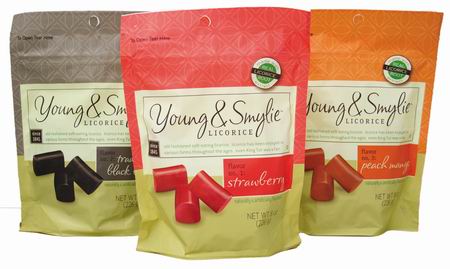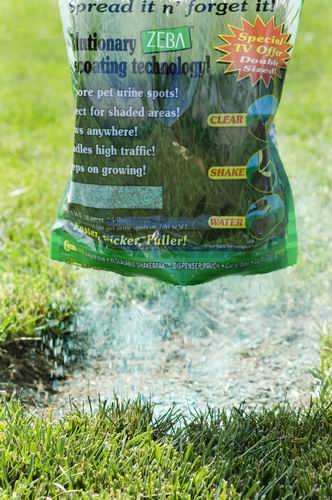As I promised in my previous post “The Evolution of the Stand-Up Pouch” in this post we shall take a look at some stand-up pouches which feature in one way or another a speciality. There are innumerable ways to design original stand-up pouches using the ultimate in technology to accentuate the brand’s presence on the shelves. Keep in mind that more than two thirds of purchasing decisions are made in the aisle. The competition is decided then and there by what the consumer favours, and it is on the shelves that the brand must make the impact. The only problem is, as it often is in the packaging world, the application of revolutionary technologies and/or material compositions, isn’t always recognised or even recognisable by the consumer.
All pouches described here, have in common that they are special in one way or another. All used the ultimate developments in packaging technology, printing techniques, material composition and design. All are outstanding examples of how the DoyPack evolved to a mature and very popular packaging format. All are claiming ‘green credentials’.
Young & Smylie
Young and Smylie, the creators of quality confectionary products since 1845, introduced Strawberry Licorice in an 8 oz. (227 gr), re-sealable, stand-up pouch. Although the technical details about the package are proprietary, and not made public, there is still some known.

In fact the Young and Smylie pouch is a standard stand-up. The speciality lies in the printing technique used. Using an 8 ga (0,08 mil) PET-film, Printpack, one of the largest flexible and specialty rigid packaging converters in the US, printed the pouches in 9 colours on a Cerutti press using Sun Chemical inks.
The soft, natural look of the Young and Smylie Licorice pouch is created using a matte lacquer, a simple design, and small, well executed fonts. All the fonts are kept exceptionally clean with the help of Extreme-E engraving. Extreme-E is a high resolution engraving method which utilizes a machine that can engrave as low as a 2 point font without compromising the copy integrity. Compared to conventional engraving, Extreme-E technology produces engraved cells via a series of cuts. The advantage of this technology is that the smooth edges of this kind of etching can keep the small copy very legible and clean, versus the normal hounds-tooth edge of conventional engravings.
Grape Ranch Frozen Rose
Grape Ranch Frozen Rose is an all mixed and ready to throw in the freezer alcoholic beverage. Freeze till hard to the touch, tear off the top and mix in a blender, top with a favourite red wine or liqueur.
 To withstand freezing and below-freezing storage conditions, the Grape Ranch Frozen Rose stand-up pouch, made by PPi Technologies, is using a multi-layer laminate film from Amcor Flexibles, uniquely designed to contain alcoholic beverages. In the frozen beverage category it is a stand-alone since it is offered in a re-closeable, stand-up pouch. The Grape Ranch Frozen Rose packaging format and design brings differentiation and opens with its significant convenience for the consumer a whole new market in frozen alcoholic beverages..
To withstand freezing and below-freezing storage conditions, the Grape Ranch Frozen Rose stand-up pouch, made by PPi Technologies, is using a multi-layer laminate film from Amcor Flexibles, uniquely designed to contain alcoholic beverages. In the frozen beverage category it is a stand-alone since it is offered in a re-closeable, stand-up pouch. The Grape Ranch Frozen Rose packaging format and design brings differentiation and opens with its significant convenience for the consumer a whole new market in frozen alcoholic beverages..
Bertolli Premium Pasta Sauces
The 21st DuPont Awards for Packaging Innovation honoured sustainability in packaging design and construction and the Bertolli Premium-brand stand-up pouch for pasta sauces, was one of the winners.
When launched the new 13.5-oz (400 ml) stand-up pouch for Bertolli Premium boasted a sophisticated appearance on the shelves. But the pouch had more to offer beyond its striking and mouth-watering appeal. While not a replacement for the glass jars used by Unilever for its Bertolli sauces, the stand-up pouch offers consumers microwaveability that allows them to heat the product in the pouch in just 90 seconds.

Amcor Flexibles produced the non-foil pouch-stock of a 104-micron (4.09-mil), seven-colour reverse-printed barrier lamination comprising PET as outer layer, nylon as barrier and PP as sealant, which provide a nine-month shelf life for the oxygen-sensitive product. Unilever settled on the material that gave the best combination of low cost, high barrier, heat stability, microwaveability, optical clarity (the consumer can see the product through the clear, bottom panel), and machine-ability at the converter and the filling operation.
The sauces are contract-packaged on an intermittent motion Toyo Jidoki system.
ShakerPAK
ShakerPAK, manufactured by Ampac Flexibles, a Division of Ampac Packaging LLC is unique in that the bottom of the pouch, the so called bottom gusset, has been replaced with an inside perforated layer for dispensing dry solids like seed, fertilizers, and ice melt. Below the perforation is a press-to-close zipper for recloseability.
 The stand-up pouch includes a laser score tear strip for tamper evidence and product protection. The consumer needs only to open the package via the easy tear strip on the bottom of the package, pull open the zipper, position the package over the desired area with the easy-carry handle, and then shake the package to dispense the product. This allows the consumer to control where and how much product is dispensed without actually coming into contact with the product. The reclose feature protects the product from moisture for future use.
The stand-up pouch includes a laser score tear strip for tamper evidence and product protection. The consumer needs only to open the package via the easy tear strip on the bottom of the package, pull open the zipper, position the package over the desired area with the easy-carry handle, and then shake the package to dispense the product. This allows the consumer to control where and how much product is dispensed without actually coming into contact with the product. The reclose feature protects the product from moisture for future use.
The ShakerPAK stand-up pouch is only 2% by weight of the replaced bulky rigid HDPE container, providing a considerable improvement through light-weighting.
Honest Kids
Honest Kids, an organic fruit juice product of Honest Tea, has a very special and modern stand-up pouch design. Although the modern design camouflages the original construction of a stand-up pouch, all elements are there including the gusset bottom and the traditional Doyen sealing of the edges of all 4 sides of the hourglass-shaped pouch, clearly connecting front and back panel.

Honest Kids hourglass-shaped 6,75 oz (200 ml) pouches, designed by Flow Design have a modern shape, a built-in straw, and white backgrounds picturing fruit splashing into pastel shades of water. The modern design has the objective to appeal to children and the hourglass-shape helps them to grip the package. The back of the pouches have a saying or quote at the top, such as “Don’t worry if your tasks are small and rewards are few, remember that the mighty oak was once a nut like you!”
The ‘green credentials’ of this pouch look impressive: The empty pouch weighs 5,63 gr, which is only 2,7% of the gross weight, in other words 97,3% is pure fruit juice. A good ratio, if there wasn’t a small problem.
With the Honest Kids stand-up pouches Honest Tea faced ‘green’ problems since the aluminium used by its contract packer on the bottom of the juice pouch made the pouch not-recyclable. Instead of replacing it by a recyclable material, Honest Tea honed in on re-use, paying schools 2 dollar cents for every juice pouch sent back to the company.
One of Honest Tea’s partners stitches the returned pouches together to make school-supply pouches.
Is this thought to be the new circle in a ‘green’ economy? Not really, as there still is one ‘little’ problem after the life as school-supply pouches, they still can’t be recycled and will end up at landfill.
Is the Honest Kids pouch not quite honest? Does it look like ‘green-washing’?
Oscar Mayer Mini Hot Dogs
Oscar Mayer Mini Hot Dogs, in a compact, stand-up pouch, embodies the essential characteristics of a packaging for a grab-and-go snack. The 10-oz (283 gr) pouch contains approximately 20 precooked Oscar Mayer Mini Hot Dogs, which are smaller than their full-size counterparts, but a bit larger than cocktail wieners.
The bottom-gusset pouch stands approximately 7” (19 cm) tall and 7” (19 cm) wide, providing a bright and visible billboard for the product in the refrigerated section. The pouch’s bottom gusset is made of clear film allowing the consumer a view at the miniature hot dogs inside. The front and back panel of the pouch appear to be a foil lamination. Consequently the hot dogs can’t be heated in the microwave when still sitting in the pouch.

The resealability of the pouch is enabled with a Zip-Pak Slider zipper, which employs a “clip” that slides back and forth, allowing the consumer to open and close the pouch. Before it is opened the first time, the FreshSlide zipper, as it is baptized by Oscar Mayer, is covered with a hood of film to be removed by gripping the side of the bag and tearing across the top. Once opened, the pouch provides the mini hot dogs with a seven-day refrigerated shelf life.
This short overview gave the most interesting stand-up pouches based on the standard DoyPack construction in recent time. I will close this cycle of posts about stand-up pouches with an article devoted to special designs. A special development in the stand-up pouches is the section where the in a stand-up pouch packaged food product is sterilized or pasteurised via an autoclave or retort process. The characteristics of retort sterilization require special materials. The retort pouch gained popularity in part from developments of ready-to-eat meals for the armed forces. In fact these packages for the military, officially known as tri-laminate retort pouches, aka “flexible cans”, got essentially the retort-pouches started.
Another item I shall describe in my next post are the designs that found their base in the original DoyPack but underwent such modifications that you barely can call them stand-up pouches anymore. The first will be the PushPop of Amcor and the second, one of the most amazing evolutions in the stand-up pouch, the S-Pouch, a double gusset stand-up pouch, which not only offers benefits in comparison to the standard stand-up pouch but also offers amazing options for fitments.

I have a quick question.
In your article about Honest Beverage, you talking about the design of the pouch been done by a company called “Flow Design” is that correct????
I don’t think so, because I have the same pouch, same shape and same function in my hand.
Pingback: Excellence in Packaging » Blog Archive » Short, Shorter, the Shortest·
The article said, “using an 8 ga (0,08 mil) PET-film”. I do not think this is accurate because a film of this thickness is too thin for this application. It must be a printing error.
Obviously you are right. 8 ga is too thin for a film. I got this info from the supplier (and didn’t use my brain). Sorry, I have to check it with them.
I presume that it should be 8 point (and not gauge), which is roughly 200 mu or 0.2 mm.
Sounds better, however the point is used within the paper industry and not in the plastic film industry. I have to check it, I come back to you in due course.
I also notice the 8 ga issue in PrintPack description, as far as I know the lowest thickness for PET films available for printing is 8 microns which is equals roughly to 30 ga or 0,30 mil.